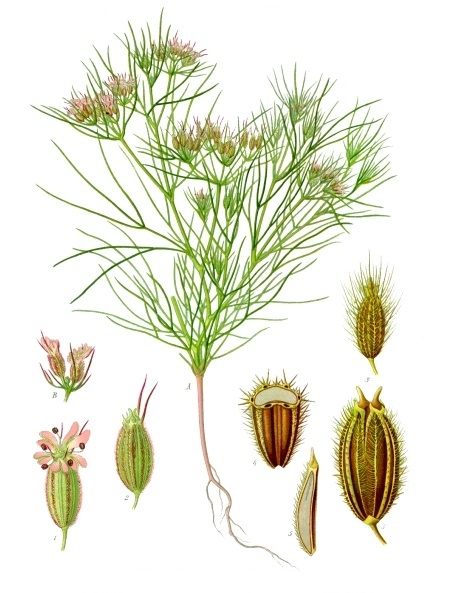CUMIN

Cumin is the dried seed of the herb Cuminum cyminum, a member of the parsley family. The cumin plant grows to 30–50 cm (12–20 in) tall and is harvested by hand. It is an annual herbaceous plant, with a slender, glabrous, branched stem which is 20–30 cm (8–12 in) tall and has a diameter of 3–5 cm (1 1⁄4–2 in). Each branch has two to three sub-branches. All the branches attain the same height, therefore the plant has a uniform canopy. The stem is coloured grey or dark green. The leaves are 5–10 cm (2–4 in) long, pinnate or bipinnate, with thread-like leaflets. The flowers are small, white or pink, and borne in umbels. Each umbel has five to seven umbellts. The fruit is a lateral fusiform or ovoid achene 4–5 mm (1⁄6–1⁄5 in) long, containing two mericarps with a single seed. Cumin seeds have eight ridges with oil canals. They resemble caraway seeds, being oblong in shape, longitudinally ridged, and yellow-brown in colour, like other members of the umbelliferae family such as caraway, parsley and dill.

ETHNOMEDICAL/FOLKLORE USAGE
Ayurveda is an ancient Indian therapeutic system, which is based on the curative properties of plants and plant derived products. A very large number of medicinal herbs of various taxonomic genera are included in many forms in this traditional therapy, which are also relied upon in other other indigenous systems of medicine practiced in Southeast Asia, such as Siddha and Unani systems. In these traditional therapies, cumin as well as caraway seeds are prominently considered carminative, eupeptic,
antispasmodic, astringent and used in the treatment of mild digestive disorders, diarrhea, dyspepsia, flatulence, morning sickness, colic, dyspeptic headache and bloating, and are said to promote the
assimilation of other herbs and to improve liver function. They have also been used in
bronchopulmonary disorders and as a cough remedy, as well as an analgesic.
In fact, medicinal usage of cumin and caraway seeds has also been immensely widespread in diverse
ethnomedical systems from Northern Europe to the Mediterranean regions, Russia, Iran, Indonesia and
North America, where these have remained as an integral part of their folk medicines.
BIOLOGICAL AND PHARMACOLOGICAL ACTIVITY
Cumin products (oil sa well as their aqueous and solvent derived axtracts) have shown significant antioxidant activity in several test methods. These effects are documented as their ability to prominently quench hydroxyl radicals, 1,1-diphenyl-2-picrylhydrazyl (DPPH) radicals and lipid peroxides. The other assays employed were ferric thiocyanate method in linoleic acid system, Fe2+ ascorbate-induced rat liver microsomal lipid peroxidation (LPO), soybean lipoxygenase dependent lipid peroxidation and ferric reducing ability. The antiradical profile of cumin has been propsed as the underlying mechanism for its multifaceted pharmacological properties such as antimicrobial, antidiabetic, anticarcinogenic/antimutagenic, antistress, antiulcerogenic,etc. The antibacterial action was assessed against a range of useful and pathogenic gram-positive and gram-negative bacterial strains. Cum seed and oil alcoholic extract inhibited the growth of Klebisella pneumoniae and its clinical isolates and caused improvement in cell morphology, capsule expression and decreased urease activity. This property was attributed to cuminaldehyde.
In independent studies, dietary supplementation of cumin was found to prevent the occurrence of rat colon cancer induced by a colon-specific carcinogen, 1,2-dimethylhydrazine (DMH). In cumin receiving animals, no colon tumors were observed. The excretion of fecal bile acids and neutral sterols was significantly increased, and cumin was shown to protect the colon and to decrease the activity of beta-glucuronidase and mucinase enzymes. Beta-glucuronidase increases the hydrolysis of glucuronide coniugates and liberates the toxins, while the increase in mucinase activity may enhance the hydrolysis of the protective mucins in the colon. Histopathological studies also showed lesser infiltration into the submucosa, fewer papillae and lesser changes in the cytoplasm of the cells in the cumin-treated colon. In cumin-treated rats, the levels of cholesterol, cholesterol/phospholipid ratio and 3-methylglutaryl COA-reductase activity were reduced.
Influence of spices on the bacterial (enzyme) activity in experimental colon cancer.1998
The anti-tumorigenic activity was already attribuited to the ability of cumin in modulating carcinogen metabolism via carcinogen/xenobiotic metabolizing phase I and phase II enzymes. Activities of cytochrome (CYP) P-450 reductase and CYP- b5 reductase were augmented, whereas phase II enzymes GAST and DT-diaphorase were increased.
Chemopreventive effects of Cuminum cyminum in chemically induced forestomach and uterine cervix tumors in murine model systems.2003
In a glocuse tolerance test conducted in rabbits, cumin significantly increased the area under the glucose tolerance curve and hyperglycemic peak. A methanolic extract of cumin seeds reduced the blood glucose and inhibited glycosylated hemoglobin, creatinine, blood urea nitrogen and improved serum insulin and glycogen (liver and skeletal muscle) content in alloxan and streptozotocin (STZ) diabetic rats. The collateral benefits included devreased creatinine, urea nitrogen and improved insulin and glycogen in tissue and skeletal muscles, accompanied by a reduction in rat tail tendon collagen-linked fluorescence and pepsin digestion which are implicated in the pathogenesis of diabetic microvascular complications. The biologically active constituent of cumin seed oil was characterized as cuminaldehyde which inhibited aldose reductase and alpha-glucosidase isolated from rat. In hyperglycemia associated with diabetes, the use of aldose reductase inhibitors has shown efficacy in attenuating diabetic complications.
PUBLISHED STUDIES
Cuminum cyminum: antihyperglycemic activity in diabetic rats
STZ-induced diabetes is the most widely used animal model of human diabetes mellitus. Diabetes arises from irreversible destruction of pancreatic beta cells causing reduction in insulin secretion. Diabetic rats showed symptoms of polyuria, polyphagia and polydipsia which were reversed on treatment with Cuminum Cyminum (CC) and glibenclamide. Treatment with CC and glibenclamide reduced elevated blood glucose and increased serum insulin and glycogen content. Sulphonyl ureas such as glibenclamide stimulate insulin secretion from pancreatic beta cells principally by inhibiting ATP-sensitive K+ channels. CC may bring about reduction in blood glucose through stimulation of surviving beta cells to produce more insulin. Protection of pancreas on treatment with CC was observed as indicated by reduction in lipid peroxidation and increase in antioxidants like superoxide dismutase, catalase and reduced glutathione. It is known that antioxidant treatment suppressed apoptosis and exerted beneficial effect on pancreatic beta cells. In response to enhanced insulin levels, the glycogen content in skeletal muscle and liver was found to increase. Thus antihyperglycemic effect of CC may be due to protection of surviving pancreatic beta cells, increase in insulin secretion and glycogen storage.


‘‘Unifying hypothesis” suggest that the initiator of hyperglycemia induced diabetic nephropathy is due to excess generation of mitochondrial superoxides, which then leads to activation of four major biochemical pathways, including increase AGE formation, activation of protein kinase C, increased flux through polyol pathway and hexosamine pathway. Diabetic rats showed increased kidney lipid peroxidation (TBARS), reduction in antioxidant defense and increase in renal AGE. This is in agreement with other authors who reported a significant increase in renal AGE formation in STZ-induced diabetic rats. Renal damage was evident with increase in serum creatinine and BUN indicating reduced creatinine and urea clearance. A decrease in renal function also increases circulating AGE concentrations by reduced clearance as well as increased formation. AGEs are involved in structural changes in diabetic nephropathy such as glomerulosclerosis, interstitial fibrosis and tubular atrophy consequently affecting kidney functions. Treatment with CC and glibenclamide reduced oxidative stress by increasing antioxidant defense and reducing free radical induced lipid peroxidation. Increased oxidative stress was associated with increased formation of renal AGE in diabetic rats which was reduced on treatment with extract and glibenclamide. Effect of CC 600 mg/kg on reducing oxidative stress and renal AGE was significantly (p < 0.05) better than glibenclamide. This effect was reflected by improved creatinine and BUN levels in diabetic rats treated with CC 600 mg/kg. CC 600 mg/kg improved renal function to near normal and was significantly better than glibenclamide.

Antihyperglycemic activity and inhibition of advanced glycation end product formation by Cuminum cyminum in streptozotocin induced diabetic rats.2010
Antiglycating potential of cumin and modulation of alfa-crystallin chaperon activity against diabetic cataract
Structural proteins called crystallins largely determine the transparency of the eye lens. Alfa-crystallin, a member of the small heat shock protein family, is a major structural element in the protein matrix of the vertebrate eye lens. In addition to its structural role, alfa-crystallin is shown to exhibit chaperone-like function by preventing the aggregation of several proteins denaturated by heat or other stress conditions. Because of their remarkable longevity, crystallins (including alfa-crystallin) in the lens are susceptible to several posttranslational modifications (PTM) including nonenzymatic glycation during aging and diabetes. Furthermore, various PTM whose formation is accelerated during aging and in diabetes were shown to cause intra- or intermolecular cross-linking of alfa-crystallin, decreasing the chaperone function as well. Alfa-cristallin isolated from glycated total soluble proteins (TPS) of the lens loss of chaperone activity compared to alfa-crystallin isolated from the control, and co-incubation with cumin extract had a slight protective effect against loss of the chaperone activity of alfa-crystallin.

Chaperone activity of alfa-crystallin isolated from in vitro glycated TPS as assessed by heat-induced aggregation of betaL-crystallin at 60°C. BetaL-crystallin was incubated in the absence (trace 1) or presence of alfaL-crystallin isolated from control TPS (trace 2),glycated TPS in the absence (Trace 3) or presence of 1 mg/ml cumin (trace 4).
There was an increase in the food intake in untreated and cumin-fed diabetic rats compared to control rats. Despite the increased food intake, the body weight was decreased when compared to the controls. The onset of cataract was observed after 4 weeks in diabetic rats, whereas all lenses were clear and normal in control rats. Although data suggest that the progression of cataract due to STZ-induced hyperglycemia from onset through maturation was delayed in groups of rats whose diet was supplemented with 0.5% cumin.
Average fasting glucose levels in control, diabetic and cumin-treated subjects were 80, 290 and 240 mg/dL, respectively. Cumin significantly decreased the percentage of glycated hemoglobin and protein carbonyls in diabetic rats. As expected, diabetes resulted in the formation of glycated protein in the TPS of untreated diabetic rats as determined by boronate affinity chromatography, and cumin supplementation notably decreased the amount of glycated protein in diabetic rats.

The effect of cumin on the amount of glycated protein in rat lens TPS analyzed by phenyl boronate affinity chromatography. GI: control rats, GII: untreated diabetic rats, GIII: cumin-fed diabetic rats.
It should be noted that even though there is a partial lowering of blood glucose, cumin feeding resulted in a delay of cataract progression, which could be attributed at least partly to the modulation of structure and function of alfa-cristallin.
Delay of diabetic cataract in rats by the antiglycating potential of cumin through modulation of α-crystallin chaperone activity.2007
Simone Chiola